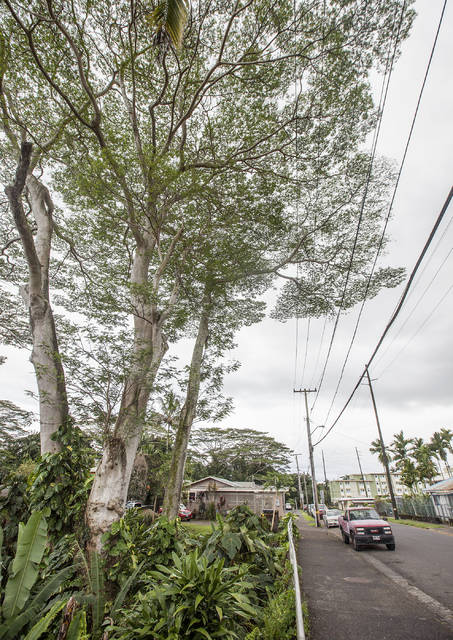HILO — A series of projects to curb albizia growth along county roadways are awaiting additional funding before they can be completed.
The Big Island Invasive Species Committee recently completed most of a project to eradicate the invasive albizia trees lining five miles of the Puainako Street extension. However, Springer Kaye, manager for the Invasive Species Committee, said funding for that project dried up just before it could be completed, leaving one stand of the trees remaining.
That project was one of several planned by the Albizia Task Force — including representatives from the Invasive Species Committee, the state Department of Transportation, Hawaii Electric Light Co., and more — to be carried out over a five-year period starting in 2015.
Many of those projects have been completed, including, most recently, a project on Makuu Drive in Puna which Kaye said was finished within the last few weeks, although the remaining projects await additional funding before they can be done.
“It’s a bit of feast and famine with us,” said Franny Brewer, communications director for the Invasive Species Committee. “Some years, we get funding for albizias, and then some years we don’t get much.”
Brewer said treating albizias — an invasive species prone to shedding branches, which can damage infrastructure and cause injuries — is a relatively simple and inexpensive process when they are away from populated areas, where they can be treated with herbicide and removed.
Removal projects become expensive when the trees are near infrastructure such as power lines or roadways, Brewer said, because arborists have to prune overhanging branches before the trees can be taken down. Unfortunately, such projects are of a high priority precisely because of their proximity to vital infrastructure.
Brewer said the Invasive Species Committee has multiple sources of funding, but added that additional funding would most likely come from whatever funds are budgeted to the state Department of Transportation this year. Last year, the task force’s projects cost more than $1 million, while in 2017 Hawaii County Public Works spent more than $600,000 on hazardous tree removal projects.
Kaye said, should additional funding be granted this year, the task force likely will conclude its project on Puainako — the remaining albizias there are dangerously large, Brewer said — before targeting properties on Kahakai Boulevard in Pahoa, where there is a dangerously high concentration of the trees.
“That one’s a problem, because there are hundreds of properties there,” Kaye said. “The properties are small, but the trees are huge.”
Removing albizias anywhere can be a time-consuming process, Kaye said, although treating the trees themselves often just requires an application of herbicide. The owners of each property where albizias grow must grant permission before the task force can treat the trees, which can be difficult if the owners are out of state.
Brewer said community volunteers have taken it upon themselves to map locations of potentially dangerous trees and contact out-of-state property owners in order to facilitate the trees’ removal.
Brewer also was enthusiastic about a pair of bills in the state Legislature that would allow neighbors of absentee landowners to enter an adjacent property to remove albizias if they appear to be a threat.
Brewer also highlighted House Bill 201, which would authorize state and county agents to enter private property to eradicate invasive species when there is a reasonable suspicion that they are present on the property.
All three bills have passed their first reading after crossing over into their nonoriginating chamber.



